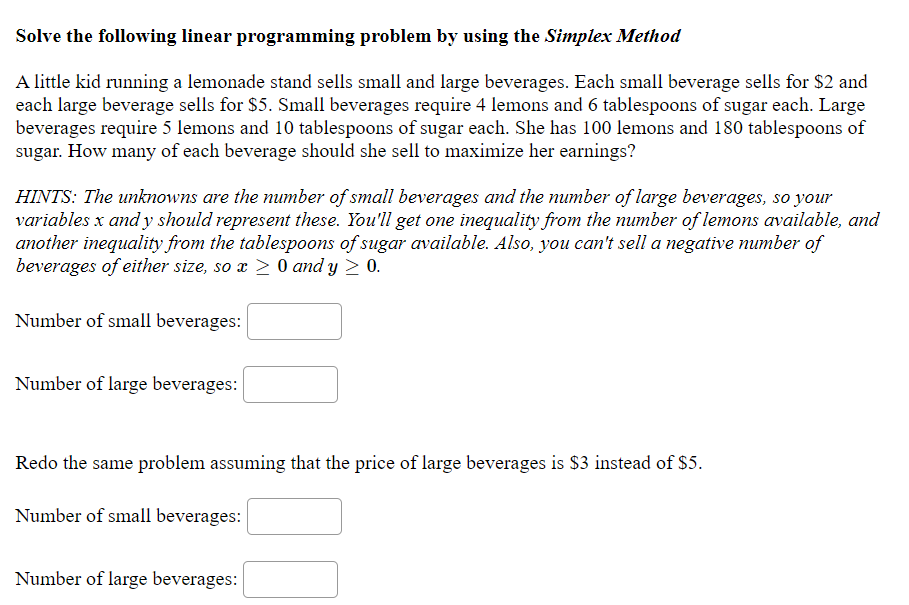Solve the following linear programming problem by using the Simplex Method A little kid running a lemonade stand sells small and large beverages. Each small beverage sells for $2 and each large beverage sells for $5. Small beverages require 4 lemons and 6 tablespoons of sugar each. Large beverages require 5 lemons and 10 tablespoons of sugar each. She has 100 lemons and 180 tablespoons of sugar. How many of each beverage should she sell to maximize her earnings? HINTS: The unknowns are the number of small beverages and the number of large beverages, so your variables x and y should represent these. You'll get one inequality from the number of lemons available, and another inequality from the tablespoons of sugar available. Also, you can't sell a negative number of beverages of either size, so x > 0 and y > 0. Number of small beverages: Number of large beverages: Redo the same problem assuming that the price of large beverages is $3 instead of $5. Number of small beverages: Number of large beverages:
Solve the following linear programming problem by using the Simplex Method A little kid running a lemonade stand sells small and large beverages. Each small beverage sells for $2 and each large beverage sells for $5. Small beverages require 4 lemons and 6 tablespoons of sugar each. Large beverages require 5 lemons and 10 tablespoons of sugar each. She has 100 lemons and 180 tablespoons of sugar. How many of each beverage should she sell to maximize her earnings? HINTS: The unknowns are the number of small beverages and the number of large beverages, so your variables x and y should represent these. You'll get one inequality from the number of lemons available, and another inequality from the tablespoons of sugar available. Also, you can't sell a negative number of beverages of either size, so x > 0 and y > 0. Number of small beverages: Number of large beverages: Redo the same problem assuming that the price of large beverages is $3 instead of $5. Number of small beverages: Number of large beverages:
College Algebra (MindTap Course List)
12th Edition
ISBN:9781305652231
Author:R. David Gustafson, Jeff Hughes
Publisher:R. David Gustafson, Jeff Hughes
Chapter6: Linear Systems
Section6.8: Linear Programming
Problem 32E
Related questions
Question

Transcribed Image Text:Solve the following linear programming problem by using the Simplex Method
A little kid running a lemonade stand sells small and large beverages. Each small beverage sells for $2 and
each large beverage sells for $5. Small beverages require 4 lemons and 6 tablespoons of sugar each. Large
beverages require 5 lemons and 10 tablespoons of sugar each. She has 100 lemons and 180 tablespoons of
sugar. How many of each beverage should she sell to maximize her earnings?
HINTS: The unknowns are the number of small beverages and the number of large beverages, so your
variables x and y should represent these. You'll get one inequality from the number of lemons available, and
another inequality from the tablespoons of sugar available. Also, you can't sell a negative number of
beverages of either size, so x > 0 and y > 0.
Number of small beverages:
Number of large beverages:
Redo the same problem assuming that the price of large beverages is $3 instead of $5.
Number of small beverages:
Number of large beverages:
Expert Solution
This question has been solved!
Explore an expertly crafted, step-by-step solution for a thorough understanding of key concepts.
This is a popular solution!
Trending now
This is a popular solution!
Step by step
Solved in 2 steps with 1 images

Recommended textbooks for you

College Algebra (MindTap Course List)
Algebra
ISBN:
9781305652231
Author:
R. David Gustafson, Jeff Hughes
Publisher:
Cengage Learning

College Algebra (MindTap Course List)
Algebra
ISBN:
9781305652231
Author:
R. David Gustafson, Jeff Hughes
Publisher:
Cengage Learning